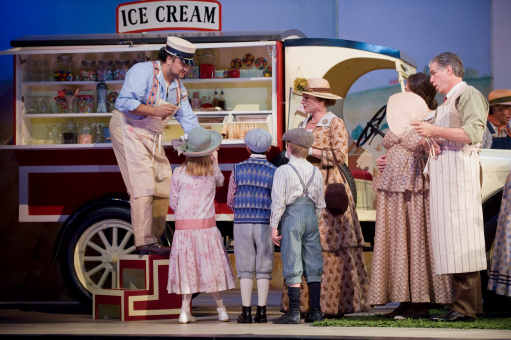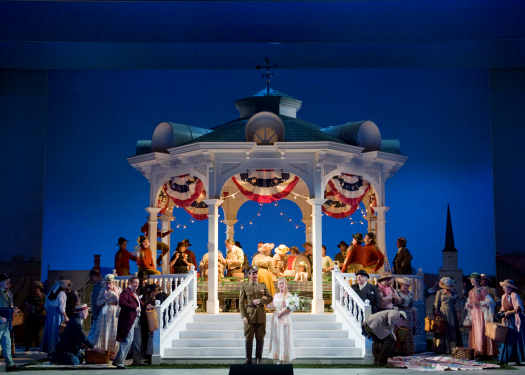Other Links
Editorial Board
- Editor - Bill Kenny
Founder - Len Mullenger
Google Site Search
SEEN
AND HEARD INTERNATIONAL OPERA REVIEW
Donizetti, The Elixir of Love: Soloists, Orchestra and Chorus of San Francisco Opera, Conductor Bruno Campanella, War Memorial Opera House, San Francisco, 29.10.2008 (HS)
In the very first scene of The Elixir of Love, re-set to a
small town in nearby Napa Valley instead of "a small Italian
village," we meet Nemorino scooping ice cream for a gaggle of
children. From the vintage of his ice cream truck and the costumes,
it's around 1915. He sees Adina on the town bandstand, wearing a
sash proclaiming her "Queen of the Harvest" and signing up
townspeople for library cards. He prepares a strawberry ice cream
cone for her, but in delivering it he falls face-first and the ice
cream tumbles to the ground. He picks it up, balances it on the cone
and sheepishly offers it to her. She laughs and turns away.
Using painted flats and a Victorian bandstand as a unit set, the
staging depicts a bucolic Napa Valley before its current incarnation
as a luxury wine region. Those who know the Frank Loesser musical,
also set in a early-20th-century Napa Valley, might be forgiven for
thinking of "The Most Happy Fella." In this story, infatuated with
Adina, he buys an elixir from a traveling quack, supposedly like the
one Isolde gave Tristan in the story Adina reads aloud in Scene I.
Before the elixir (actually red wine) can work, Adina agrees to
marry the army sergeant, Belcore, who rolls into town with a squad
of recruits. It becomes clear, however, that Adina is only doing it
to get to Nemorino, who joins the army to get the money to buy more
of the elixir. Meanwhile, the whole town hears the rumor that he
has inherited a fortune from a rich uncle, and when all the women
flock to him, he's convinced that it's the elixir at work. In the end, Adina
chooses him and pays off the sergeant to get Nemorino out of the
army.
Each character enters with a flourish. Dr. Dulcamara, the quack
medicine man, played here by bass Alessandro Corbelli, arrives on a
motorcycle with a sidecar. He places his suitcase full of elixir
bottles on a small folding table, not the elaborate wagon seen in
other productions. Corbelli does not overplay the character, either.
You can tell he's a slick con man, but he's charming about it, not
blatant. And he sings the music with spot-on articulation and
diction. A team of leather-helmeted football players precedes
Belcore, who practices plays with them as he sings his entrance
aria. Baritone Giorgio Caoduro plays the character as pompous but
totally unaware of it. He is just the school sports star a few years
older. He also displays the best coloratura in the cast.
Cast:
Adina: Inva Mula (soprano)
Nemorino: Ramón Vargas (tenor)
Belcore: Giorgio Caoduro (baritone)
Dulcamara: Alessandro Corbelli (bass)
Giannetta: Ji Young Yang (soprano)

Nemorino: Ramón Vargas
In one deft moment, director James Robinson establishes the setting
and the personalities of the two protagonists. Nemorino, played by
tenor Ramón Vargas, is awkward and shy, and clearly infatuated with
Adina, played by Inva Mula. She may be bookish but the town adores
her. You can tell by the way they follow her around. The way she
smiles at Nemorino, you can tell that she likes him but considers
him unworthy. She's a dish and she knows it. It's only the first of
many delightful and telling moments in this charming, colorful and
apt production.

The Act I Set
Vargas has a clear, high, lyric sound that's ideal for Nemorino. He
doesn't play him as a bumpkin; he is just awkward and has low
self-esteem. Mula has the slim, adorable looks and the light, creamy
soprano to make an audience fall in love with her character. She
knows who she is, and clearly is accustomed to getting her way.

Ramón Vargas and Inva Mula
But the stars are Vargas and Mula. In the opera's most famous aria,
"Una furtiva lagrima," Vargas spun out a gorgeous filament of sound,
keeping the pulse of the music going while conveying the character's
joy at seeing a telltale tear on Adina's face, evidence that she
does indeed care for him. Mula, for her part, sang with youthful
ease, creating a series of touching moments with Vargas as their
relationship circles in on its denouement.
In the pit, conductor Bruno Campanella led a straightforward effort
that sparkled just enough to keep everything moving along nicely,
though not quite with the élan of the best performances of this
familiar opera.
This being San Francisco, food is a running theme in this staging.
Nemorino makes a sundae for Adina, which they share during their Act
I duet, suggesting that Adina really might have feelings for him.
Later, Adina idly snitches a few maraschino cherries from his truck.
To drown his sorrows after Adina leaves Belcore before their wedding
is completed the sergeant sits down to eat a whole pie during his
Act II lament. He chooses it from an array of pastries brought by
the townsfolk.
In the end, having won Adina, Nemorino repaints the generic "ice
cream" sign atop his truck to say "Nemorino's Ice Cream," indicating
that he finally has some self-esteem. And he definitely has become
the most happy fella.
Harvey Steiman
Pictures © Terrence McCarthy
Back
to Top
Cumulative Index Page
